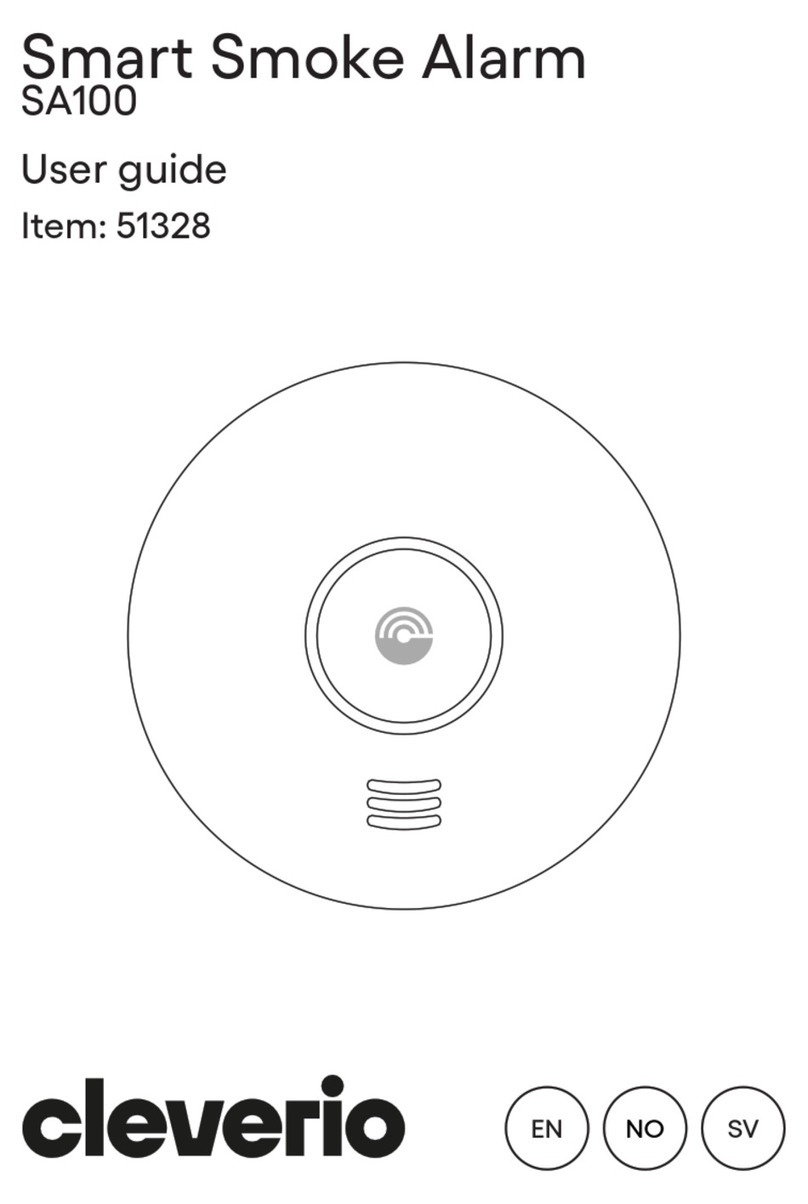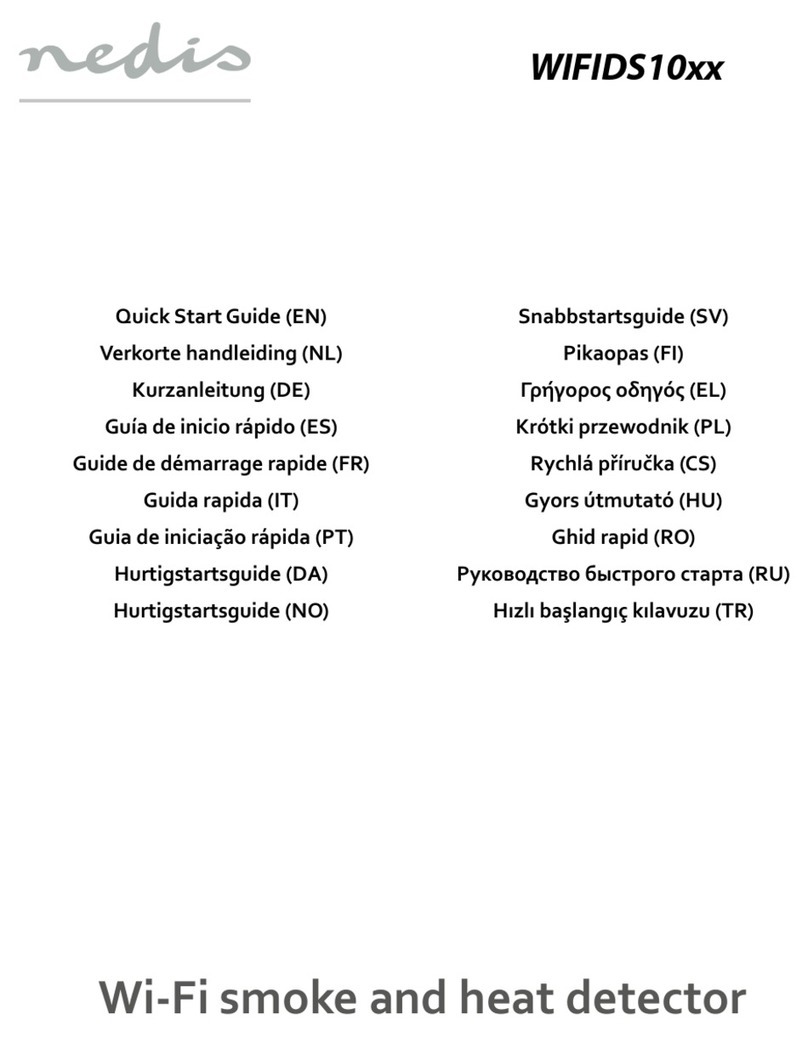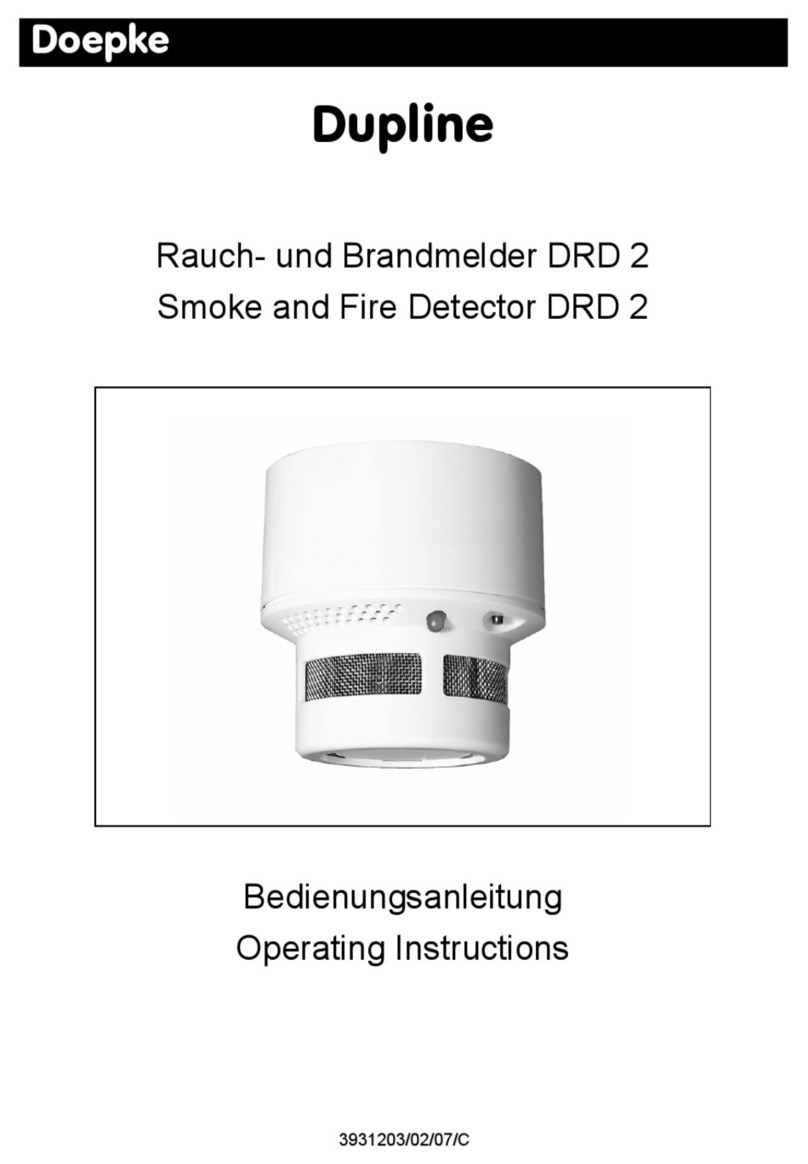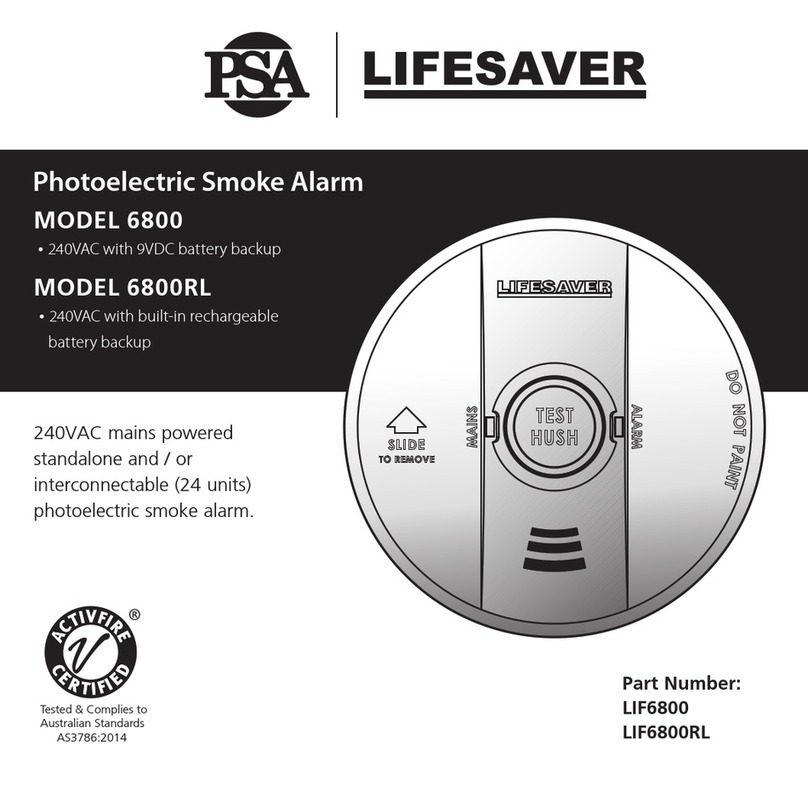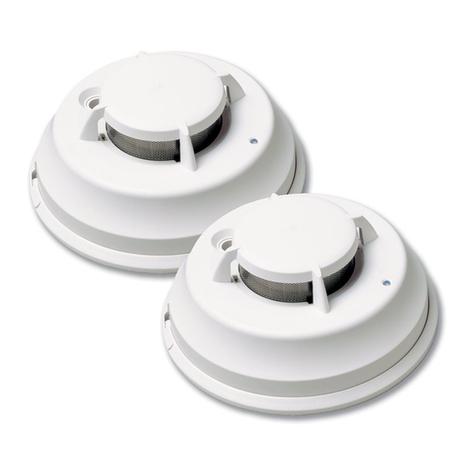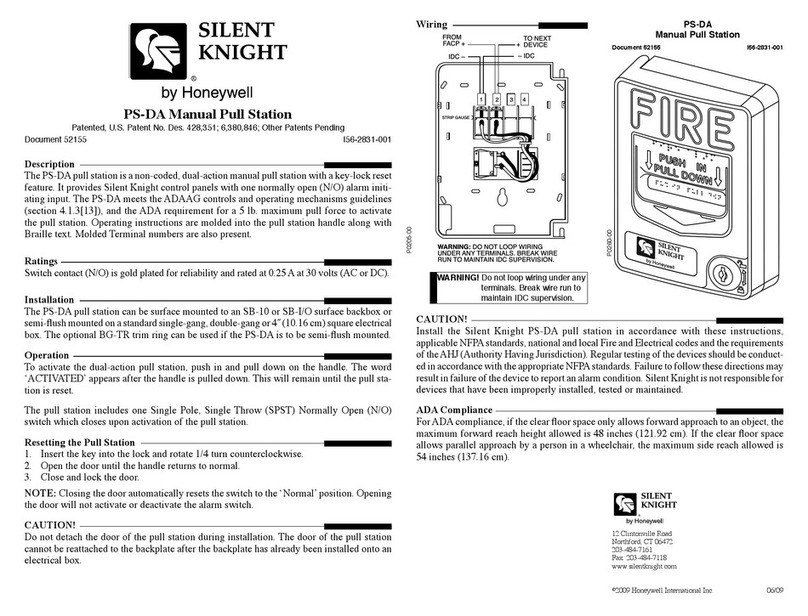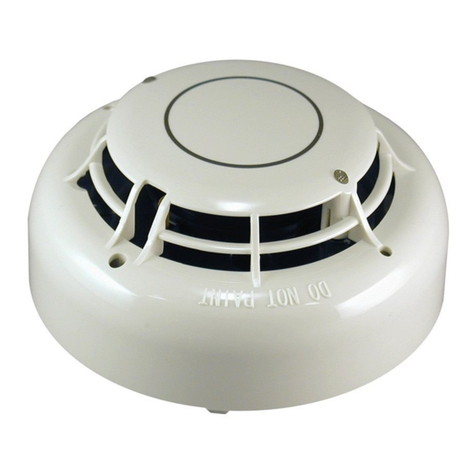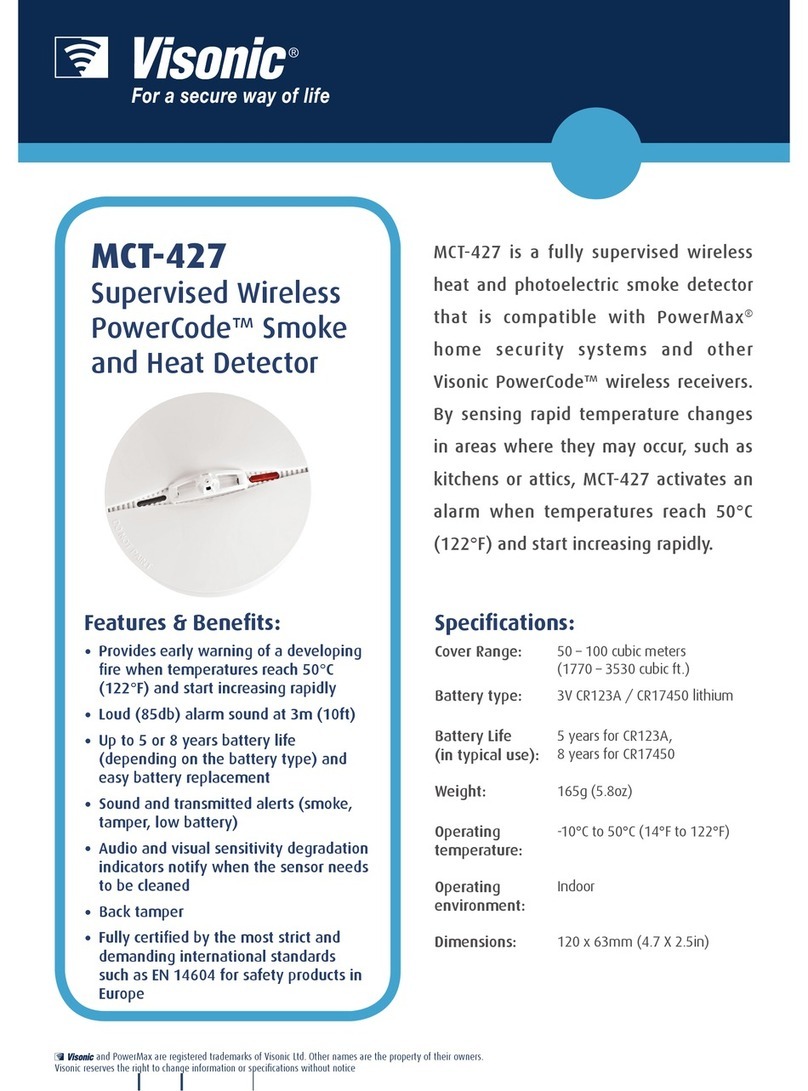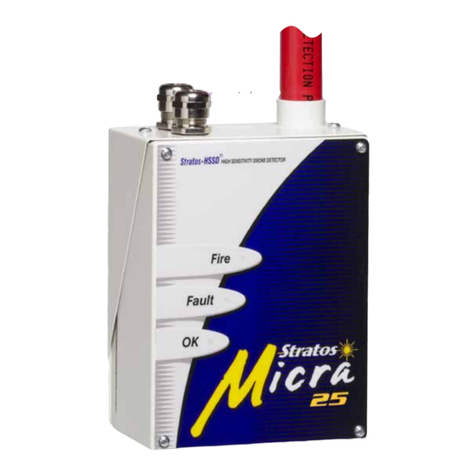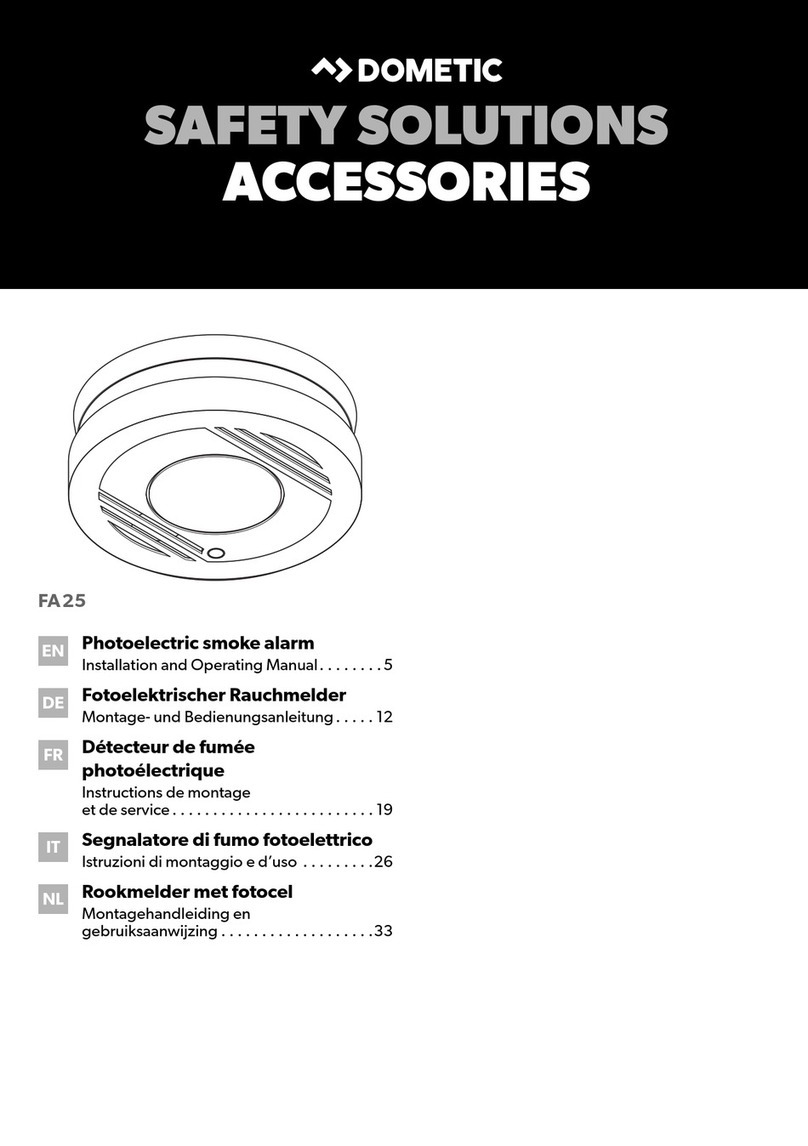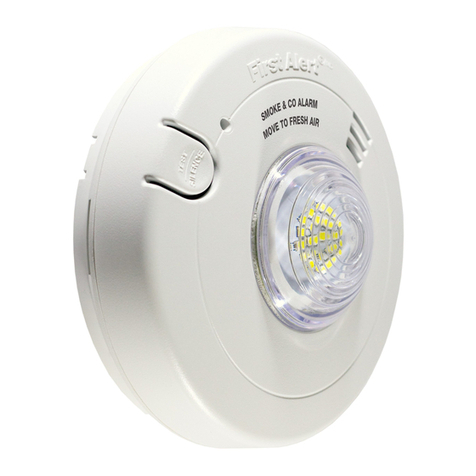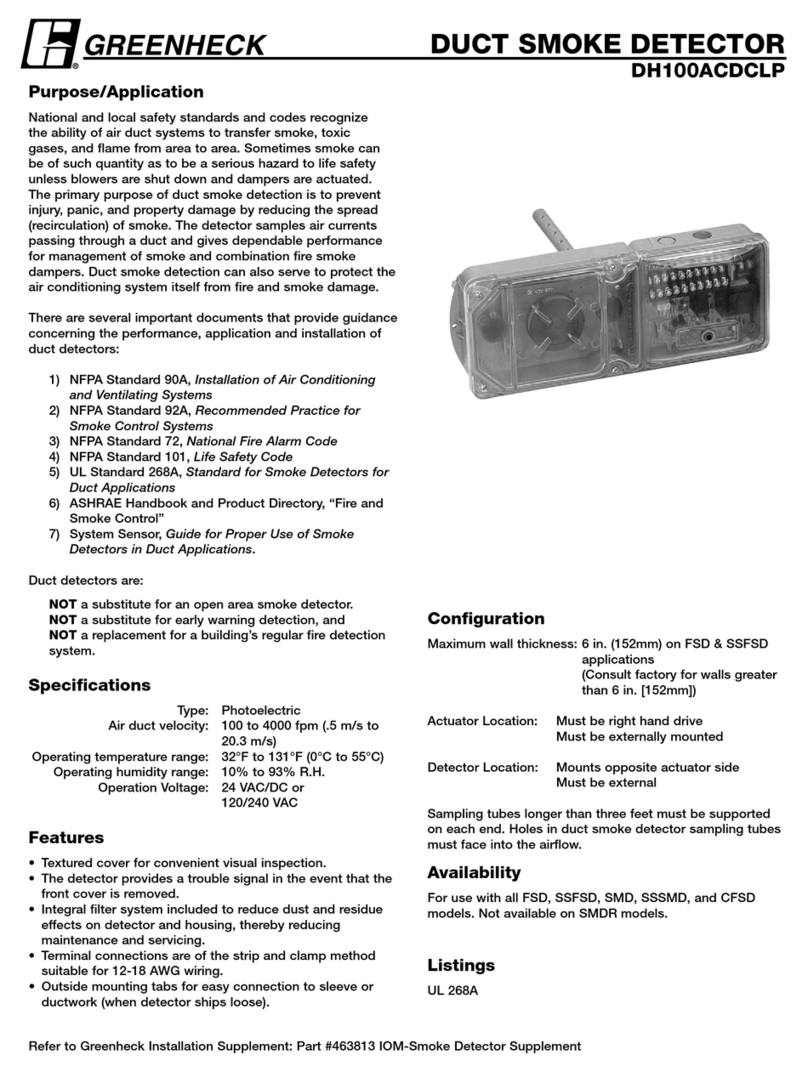ESMI EB-6500R User manual

I56-3881-001EB200-01-02 1
DEUTSCH
ESPAÑOL
ENGLISH ITALIANO
GENERAL
The model EB-6500R is a conventional long range projected beam smoke
detector designed to provide open area protection. It consists of a combined
transmitter/receiver unit and a reector. Smoke entering the area between
the two components causes a reduction in the signal returned to the receiver.
When the obscuration reaches alarm thresholds, selected at the transmitter/
receiver unit, the detector generates an alarm signal. Complete blockage of
the beam causes a fault signal. Slow changes in obscuration due to a build
up of dirt or dust on the lens of the detector are compensated for by a micro-
controller that continuously monitors the signal strength and periodically
updates the alarm and fault thresholds. When the self-compensation circuit
reaches its limit, the detector generates a fault signal, indicating the need for
service. After local testing is complete, the yellow LED will blink a pattern to
indicate the level of drift compensation employed during the test (see Blinks
Output by Yellow LED table at back of manual).
The model EB-6500RS includes an integral servo controlled calibrated test
lter, which allows automatic remote alarm testing.
SPECIFICATIONS:
General
Range: 5to70m
70mto100musingoptional6500-
LRK/BEAMLRK
Sensitivity: Level 1: 25% Obscuration
Level 2: 30% Obscuration
Level 3: 40% Obscuration
Level 4: 50% Obscuration
Level 5: 30% to 50%
Adjusting (Acclimate)
Level 6: 40% to 50%
Adjusting (Acclimate)
Maximum angular misalignment: Detector: ± 0.5°
Reector: ± 10°
Environmental
Temperature Range: -30°C to 55°C
Humidity: 10% to 95% Relative Humidity
(Non-condensing)
Mechanical
Dimensions (Without Faceplate): 229mm x 178mm x 84mm
Dimensions (With Faceplate): 253mm x 193mm x 84mm
Wiring: 0.3mm² to 3.2mm²
Adjustment Angle: ±10° Horizontal and Vertical
Electrical
Voltage Range: EB-6500R: 10.2 to 32 VDC
EB-6500RS: 15 to 32VDC
Avg. Standby Current: 17mA at 24 VDC
Max. Alarm Current: 38.5mA at 24VDC
Max. Fault Current: 8.5mA at 24 VDC
EB-6500RS Test Mode: 500mA peak
Relay Contact Ratings: 0.5A at 30 VDC
Remote Output (Alarm): Voltage: 15 to 32VDC
dependantonsupply
Current: 6mAto15mA,
Limited by 2.2KΩ Resistor
PARTS LIST
Description Quantity
Transmitter/ReceiverUnit 1
PaintableTrimRing 1
Reector (6500REFL) 1
Pluginterminalblocks 5
Instruction Manual 1
Orange Alignment Assistance Label 1
Alarm 0 ohm Shunt 1
Alarm Limiting Resistor 470 ohm 1
Alarm Limiting Resistor 680 ohm 1
Alarm Limiting Resistor 1000 ohm 1
Schottky Diode 1
APPROVED ACCESSORIES
6500-LRK/BEAMLRK
Long Range Kit comprising three additional 20cm x 20cm reectors, which
may be mounted in a square with the supplied reector, permitting the detector
tobeusedforrangesfrom70mto100m.
6500-MMK/BEAMMMK
Multi-Mounting Kit allowing the EB-6500 to be mounted to ceilings, or to
walls where the detector and reector cannot be mounted within 10° of one
another. One kit mounts either the transmitter/receiver unit or reector. If
the transmitter/receiver is mounted on the 6500-MMK/BEAMMMK, then the
6500-SMK/BEAMSMK must be used. Note that only a single 20cm x 20cm
reector can be mounted using the MMKs: The 6500-LRK/BEAMLRK is not
compatible with the MMKs.
6500-SMK/BEAMSMK
Surface Mounting Kit for the transmitter receiver (also used in combination
with the MMK) to give an additional 43mm depth to assist surface mounting
andtopermitsideentrycabling.
RTS151KEY
Remote test and annunciator accessory that enables the detector to be tested
remotely, providing test and reset functions, it has a Red LED to indicate alarm
conditions (Note: Back-box, if required, needs to be ordered separately - part
numberWM2348).
DETECTOR MOUNTING
Location
The EB-6500R(S) must be located in accordance with local standards and
guidelines, for example BS5839 part 1. For general information, refer to the
application guide for projected beam smoke detectors available on request
fromyoursupplier.
Mounting Position
Beamdetectors requirea verystable mountingsurface forproperoperation. A
surface that moves, shifts, vibrates, or warps over time may cause false alarm
or fault conditions. Initial selection of a proper mounting surface will eliminate
nuisance alarms and fault signals. Mount the detector on a stable mounting
surface such as brick, concrete, a sturdy load-bearing wall, support column,
structural beam, or other surface that is not expected to experience vibration
or movement over time. DO NOT MOUNT the beam detector on corrugated
metal walls, sheet metal walls, external building sheathing, external siding,
suspended ceilings, steel web trusses, rafters, non-structural beam, joists, or
other such surfaces. The reector has a much greater tolerance to movement
than the transmitter/receiver, hence in cases where only one stable mounting
surface as dened above can be used, the transmitter/receiver unit should be
mounted to the stable surface. See specications for maximum permissible
angular misalignment; movement outside these limits may cause nuisance
alarmsandfaults.
Mounting Considerations
• There must be a permanent clear line of vision between the detector and
the reector.
• Reective objects should be a minimum of 380mm from the line of sight
between the detector and reector to avoid compromise of the protected
area by reected light.
• Direct sunlight or strong lights into the transmitter/receiver unit should be
avoided. There should be a minimum of 10° between the paths of the light
sourceandthedetectorbeam.
• Operation of the detector through panes of glass should be avoided if
possible. If it is necessary to pass though glass, the angle between the
beam and glass should be set a minimum of 10° off perpendicular, and
operationthroughmultiplepanesshouldbeavoided.
Mounting
The transmitter/receiver unit may be mounted directly to the wall, with rear
cable entry. The detector base has four primary mounting holes, one in each
corner of the base. All four holes must be used to provide secure mounting. In
order to mount the detector to the wall, the outer cover must be removed after
unscrewing its four retaining screws.
INSTALLATION AND MAINTENANCE INSTRUCTIONS
EB-6500R AND EB-6500RS REFLECTIVE TYPE
PROJECTED BEAM SMOKE DETECTOR

I56-3881-001EB200-01-02 2
10°
10°
RTS151/KEY
1
2
3
4
5
6
T2-3
T2-4
T2-2
T2-1
OPTICAL LINE OF SIGHT
WALL
MOUNTING
SCREW X 4 COVER
SCREW
X 4
WALL
ACCEPTABLE MOUNTING
LOCATIONS FOR REFLECTOR
REFLECTOR
REFLECTOR
Figure 2a: Reflector Mounting Guidelines
Figure 2b: Reflector Mounting Guidelines
Please refer to the relevant kit instructions if the transmitter/receiver is to be
mounted onto the 6500-SMK/BEAMSMK or 6500-MMK/BEAMMMK allowing
more exibility for cable entry.
Figure 1: Transmitter/Receiver Wall Mounting
The reector is mounted directly to the wall using all four of its mounting holes,
one in each corner. The reector must be mounted such that the plane of the
reector is perpendicular to the optical line of sight to the transmitter/receiver
unit. The maximum tolerance for non-perpendicular mounting locations is
10°. If this tolerance is not possible, then the MMK should be used, see MMK
instructionsformountingdetails.
10° MAXIMUM
Figure 3: Detector Terminal Connections
FAULT N.C.
FAULT COM
REMOTE TROUBLE OUT
NOT USED
REMOTE ALARM OUT
AUX (-)
TEST INPUT
RESETINPUT
POWER IN (+)
POWER IN (-)
POWER OUT (+)
POWER OUT (-)
ALARM N.O.
ALARM COM
ALARM N.O.
ALARM COM
ALARM LIMITING RESISTOR
ALARM LIMITING RESISTOR
SCHOTTKY DIODE (A)
SCHOTTKY DIODE (K)
Figure 4: RTS151KEY Wiring
SEE RTS151KEY INSTALLATION INSTRUCTIONS
FOR ELECTRICAL RATINGS OF RTS151KEY
REMOTE ALARM
OUTPUT
AUX (-)
TEST INPUT
RESET INPUT
WIRING
Note: All wiring must be installed in accordance with local requirements.
Warning: Before working on the system, notify the proper authorities
that the system is undergoing maintenance and will be temporarily out of
service.
Wiring connections are made to pluggable terminal blocks, which can accept
wire sizes from 0.3mm² to 3.2mm². For best results screened cable should be
used. Refertothecontrolpanelinstructionsforcabletypelimitations
EB-6500R / EB-6500RS
1 2 3 4 1 2 3 4 1 2 3 4 1 2 3 4 1 2 3 4
T3 T2 T1 T4 T5
Signal Name Terminal Normal State Active Comment
State
Reset Input T2-4 High impedance 0V Momentarily connect
to Aux- to operate
Test Input T2-3 High impedance 0V Momentarily connect
to Aux- to operate
Aux- T2-2 0V - Internally connected to
Power -ve
Remote Alarm Out T2-1 High impedance +24V Via 2.2k ohms current
limit resistor
Remote Fault Out T3-3 High impedance +24V Via 2.2k ohms current
limit resistor
Table 0: Use of Input – Output Signals
WARNING
All INPUT and OUTPUT signal terminals are active LOW (0V)
Do not connect any other voltage to these terminals or
serious damage to the product may result.

I56-3881-001EB200-01-02 3
DEUTSCH
ESPAÑOL
ENGLISH ITALIANO
AK AK
EOL
Figure 5: Wiring Diagram
V OUT (+)
V OUT (-)
ALARM COM
V IN (+)
VIN (-)
ALARM COM
ALARM NO
ALARM NO
Figure 7: Alignment Adjustment Locations
ALIGNMENT PROCEDURE
Warning: When power is initially applied to the detector, before the alignment
procedure has been completed, it may enter fault or alarm. To prevent
unwanted alarms, disable the zone prior to applying power.
The alignment of the EB-6500R is divided into four steps: Coarse alignment,
ne adjustment, nal gain adjustment, and nal verication. It is necessary
for all four steps to be executed properly to ensure proper alignment of the
product.
Pre-Alignment Checklist
• Ensure that both the detector and reector are mounted securely to stable
surfaces.
• Ensure that all wiring is correct, and that terminal blocks are fully seated
intotheirreceptaclesonthedetector.
• Complete any wiring dressing to minimize movement to the detector once
thealignmentprocedureiscompleted.
• Ensure that the appropriate reectors are used for the installed distance.
• Ensure that the line of sight between the detector and reector is clear and
that reective objects are a minimum of 380mm from the line of sight.
• Ensure that both the detector and reector are mounted within their
operational parameters for off axis angles.
RESET
Terminals T5-1 and T5-2 provide connections used to complete the alarm circuit. A 0 ohm shunt, or current limiting resistor should be tted depending on the
application;thesearesuppliedseparately. Refertothepanelmanufacturerforcorrectcurrentlimitingresistorvalues.
Terminals T5-3 and T5-4 are used to connect the optional Schottky diode when used with active end of line monitoring; refer to panel manufacturer for details. Do
not t the diode unless it is specically required otherwise the functioning of the system will be affected. Diode polarity must be observed for correct operation.
EXTERNAL ALARM
LIMITING RESISTOR
OR SHUNT
POWER (+)
POWER (-)
INITIATING ZONE (+)
INITIATING ZONE (-)
• Disable the zone or system to prevent unwanted alarms before applying
power.
• Ensure power to the detector is “ON”.
FAULT COM
REMOTE FAULT OUTPUT
REMOTE ALARM OUTPUT
AUX (-)
TEST INPUT
RESET INPUT
Figure 6: Switch Locations
ALIGNMENT
POSITION
INDICATOR
OPTICS LOCK-DOWN
SCREWS X 2
CONTROL PANEL
ALIGNMENT
SENSITIVITY
TEST
OPTIONAL
SCHOTTKY DIODE
ALIGNMENT
MIRROR
FAULT NC FAULT NC
FAULT COM
REMOTE FAULT OUTPUT
REMOTE ALARM OUTPUT
AUX (-)
TEST INPUT
RESET INPUT
V IN (+)
VIN (-)
ALARM COM
ALARM NO
V OUT (+)
V OUT (-)
ALARM COM
ALARM NO
Step 1. Coarse Alignment
See gures 6 and 7.
1. Ensure that both of the optics lock-down screws are loosened so that the
optics will move freely.
2. Looking through the alignment mirror at both the alignment gun sight and
reector simultaneously, locate the position of the reector in the optical
sight. Note that initially this step will require some practice. An orange
sticky label is supplied, which may be temporarily mounted next to the
reector to aid initial location if the distance between the reector and the
detectorislarge.
3. Once the reector has been located, begin to adjust both the horizontal
and vertical alignment knobs so that the reector becomes centred in the
alignment mirror. Caution: If the optics are incorrectly aligned in this step,
it will not be possible to proceed with the next step.
HORIZONTAL
ADJUSTMENT
ALIGNMENT
GUN SIGHT
VERTICAL
ADJUSTMENT
DIGITAL SIGNAL
STRENGTH
READOUT
EB-6500R(S) EB-6500R(S)
ZONE
EOL
DEVICE

I56-3881-001EB200-01-02 4
Figure 8: Coarse Alignment Procedure
REFLECTOR
SCREW
LOCATIONS
Note that the alignment gun site does not give an accurate alignment. It is
sufcient only as a starting point for the next step. On completion of the ne
adjustmentprocedure, the alignment gunsitemay not appear tobecentred on
the reector.
SCREW
LOCATIONS
Figure 9: Housing Screw Locations
EYE
Step 2. Fine Adjustment
See gures 6 to 8.
1. Ensure that no objects are in the line of sight between the detector and the
reector.
2. Depress the Alignment switch once. Both the digital display and the yellow
LED should turn on indicating that alignment mode has been entered. The
display should begin reading “- -” signifying an electronic gain adjustment.
After a few moments the display will indicate a numeric value near 20.
Note: If the display reads “Lo” then the detector is not receiving enough
light from the reector. Go back and repeat the course alignment step and
verify that the proper number of reectors is used for the installed distance.
The display will continue to read “Lo” until the detector receives enough
light from the reector to continue with the ne adjustment step.
Note: In alignment mode (indicated by the yellow LED and the numeric
display) the sensitivity select and test switches are disabled.
3. Once the display shows a number, begin adjusting the horizontal and
vertical alignment knobs one at a time to increase signal level on the
display. Continue adjusting each axis one at a time going back and forth
between them until a peak value is indicated. If a value of 90 is achieved,
the detector will reduce its electronic gain. This will be indicated by a “- -”
reading on the display. When this happens halt any further adjustment
until the display again reads a numeric value. This process may occur
more than once during the ne adjustment step.
4. Once satised that it is not possible to achieve a higher reading on the
display depress the alignment switch to complete the ne adjustment
step. The digital display readout will turn “OFF” and the yellow LED will
remain “ON”.
5. Ensure that both of the optics lock-down screws are re-tightened.
Note: It may not be possible to achieve a gure close to 90 on the display
during the last adjustment iteration. Each time the gure 90 is reached
the gain is reduced, making it more difcult to achieve high values. Any
number is acceptable, provided it is the highest gure that can be achieved
after the nal gain adjustment.
Atthis timeitis sensible toset the sensitivityof the detectorusing the sensitivity
switch and digital display. See SENSITIVITY SELECTION for further details.
Step 3. Final Gain Adjustment
See gure 9.
In this step, the detector electronically adjusts its internal gain one nal time.
It is necessary to complete this step with the outer housing installed since the
housing will change the amount of light received from the reector.
1. Install the outer housing of the detector. The housing is installed by
tightening the four captive screws, one in each corner of the housing.
Note: The housing contains a gasket seal that protects the detector
circuitryfromcorrosionandmoisture. Toensurethat this gasket performs
correctly, it is necessary to tighten all four of the screws holding the outer
housinginplaceevenly.
2. Remove the protective lm from the front surface of the outer housing.
Note that the outer housing may require cleaning if any residue remains.
Useonlyasoft,dampcloth;donotuseanysolvents.
3. To initiate the nal electronic gain adjustment, the reset switch must be
depressed using a small screwdriver or similar tool. Once depressed the
yellow LED will begin to blink. On completion, the yellow LED will stop
blinking and the green LED will begin blinking, indicating that the gain
adjustment was successful.
Note: Use caution not to block the line of sight between the detector and
reector in this step.
4. Install the outer aesthetic ring by snapping it onto the outer housing.
Note: If the outer aesthetic ring has been painted ensure that the paint is
completely dry before proceeding with this step.
Step 4. Final Verification
This step is required to insure the detector has been setup correctly and will
detectsmokeatthepropersensitivitylevel.
1. With the detector functioning (dependant on the operation of the control
panel, this may be indicated by the green LED blinking), completely
block the reector with a non-reective opaque material, for example
this manual. After about 30 seconds, the detector should enter either the
fault or alarm condition. If the detector does not enter the fault or alarm
condition, there is a problem with the installation.
2. Complete a sensitivity test of the detector as described in SENSITIVITY
TESTING below.
SENSITIVITY SELECTION
The sensitivity of the detector can be set only when the housing is removed
and the detector is not in the ne adjustment step of the alignment mode. To
enter the selection mode, press the sensitivity button once (see gure 6). The
digital display will illuminate and read the current sensitivity setting in percent
obscuration. Press the sensitivity button again to rotate to the next setting.
Once the required setting is achieved (See table 1), the detector will exit the
sensitivity selection mode if no further switch presses occur.
In addition to the four standard sensitivity selections the detector has two
Acclimate settings. When either of these settings is chosen the detector
will automatically adjust its sensitivity using advanced software algorithms
to select the optimum sensitivity for the environment. The sensitivity will be
continuously adjusted within the ranges specied in graph 1.
Total obscuration can be converted to percent per metre assuming uniform
smoke density for the entire length of the beam. Graph 1 converts total
obscurationtopercentpermetreforallacceptablesensitivitysettings.
RESET SWITCH
Sensitivity Setting % Obscuration Display Reading
Level 1 25 25
Level 2 30 30
Level 3 40 40
Level 4 50 50
Acclimate Level 1 30 to 50 A1
Acclimate Level 2 40 to 50 A2
Table 1: Sensitivity Settings

I56-3881-001EB200-01-02 5
DEUTSCH
ESPAÑOL
ENGLISH ITALIANO
Test Failure Checks
If the detector fails either the sensitivity or functional test, several steps should
betaken beforereturningthe unittodetermine ifitis faulty,orsimply needstobe
re-adjusted. Thesestepsinclude:
1. Verify all wiring connections and appropriate power is applied to the
detector.
2. Verify that the optical line of sight is free from obstructions and reective
objects.
It is imperative that at least 90% of the received light is from the reector
alone, otherwise sensitivity cannot be assured.
3. Apply the maintenance procedure in this manual. Repeat the test
procedure. If the detector still fails the test procedure proceed with step 4.
4. Repeat the alignment procedure in this manual. If the alignment procedure
is successful repeat the test procedure. If the detector still fails the test it
shouldbereturnedforrepair.
EB-6500R(S) BEAM DETECTOR: SET-UP PROCEDURE SUMMARY
Beam Alignment– ensure power is on
CourseAlignment
Carryoutusingtargeteyepiece
Adjust using horizontal and vertical thumb screws
Fine Adjustment
InitiateusingAlignment Switch
Continue adjustment using horizontal and vertical thumb screws
When the adjustment is complete press the Alignment Switch
Sensitivity Setting
Select using Sensitivity Switch
Final Gain Adjustment – ensure front cover is tted
InitiateusingtheReset Switch
Completed when the green LED blinks
Final Verification
Use obscuration lters or reector test card to initiate Fire and Fault signals
MAINTENANCE
Note: Before cleaning the detector, notify the proper authorities that the
smoke detector system is undergoing maintenance, and therefore the system
will be temporarily out of service. Disable the zone or system undergoing
maintenance to prevent unwanted alarms.
1. Carefully clean the outer housing lens face. A damp soft cloth with a mild
soap may be used. Avoid products with solvents or ammonia.
2. Carefully clean the reector. A damp soft cloth with a mild soap may be
used. Avoid products with solvents or ammonia.
Functional Testing
For periodic maintenance functional testing, the detector can either be tested
using the Calibrated Test Filter method, by using the local test switch on the
transmitter receiver unit or remotely using the Remote Test Station.
The Remote Test Station, RTS151KEY, can be used with the EB-6500R(S)
beam smoke detector. The wiring diagram to connect the EB-6500R(S) to the
key is displayed on page 2 of this manual..
The EB-6500RS is equipped with an integral sensitivity test feature that
consists of a calibrated test lter attached to a servomotor inside the detector
optics. When a test is initiated using the remote test station or local test switch
the test lter is moved in the pathway of the light beam. If the correct level of
signal reduction is received the detector will enter alarm. If the proper level of
signal reduction was not achieved, indicating that the sensitivity of the detector
is out of tolerance, the detector will enter the fault condition.
Note: This test should satisfy most local periodic maintenance and testing
requirements.
If the detector fails this test, refer to the Test Failure Checks described above.
PAINTING
The outer aesthetic ring may be painted using enamel or acrylic paints either by
brushorspray.
Note: Never paint the at lens surface of the outer housing.
SENSITIVITY TESTING
NOTES:
1. Beforetesting,notifytheproperauthoritiesthatthesmokedetectorsystem
is undergoing maintenance, and therefore the system will be temporarily
out of service. Disable the zone or system undergoing maintenance to
prevent unwanted alarms.
2. Before testing the detector, check for the presence of the ashing green
LED at the receiver, making sure not to disturb or block the beam. If it does
not ash and the detector is not in fault or alarm, power has been lost to the
detector.
Detectors must be tested after installation and following periodic maintenance.
The sensitivity of the EB-6500R may be tested as follows:
Calibrated Test Filter Method
The sensitivity of the detector can be tested using an opaque material ( such
as this manual ) to cover the reector by an amount indicated by the graduated
scale on the reector, see Figure 10.
1. Verify the sensitivity setting of the detector in % obscuration. See the
Sensitivity Selection section of this manual for sensitivity determination if
sensitivity is unknown.
2. Place the blocking material over the reector, lining it up with the graduated
marks that are 10 less than the detector setting in % obscuration. The
detector should not alarm or fault. Keep the material in place for a minimum
of1minute.
3. Place the blocking material over the reector lining it up with the graduated
marks that are 10 more than the detector setting in % obscuration. The
detector should enter alarm within 1 minute.
4. The detector can be reset with the reset switch on the detector unit or
remotereset.
Figure 10. Reflector Test Card Procedure
LINE UP EDGE OF BLOCKING MATERIAL WITH
APPROPRIATE OBSCURATION LEVEL
MOVE BLOCKING MATERIAL TO
DESIRED AMOUNT OF OBSCURATION
7
GRAPH 1: SENSITIVITY (%M vs DISTANCE)
(Assuming Uniform Smoke Distribution)
5
6
Level 1
4
5
(%/Metre)
Level 2
Level 3
2
3
b
scuration
Level 4
1
O
b
0
0 10 20 30 40 50 60 70 80 90 100
Distance (Metres)

I56-3881-001EB200-01-02 6
OPERATION MODES AND TROUBLESHOOTING GUIDE
Schneider Electric Fire and Security Oy, Sokerilinnantie 11 C, 02600 Espoo, Finland
Percent the
detector has
drifted
<10%
<20%
<30%
<40%
<50%
<60%
<70%
<80%
<90%
<100%
Number
of blinks
output
None
1
2
3
4
5
6
7
8
9
Blinks Output byYellow
LED once the Device has
Passed a Local Test
Modes Red Yellow Green Dual Digital Display
Readout
Initiating Means Alarm Contacts Fault Contacts Comments and
Troubleshooting Tips
Alarm Remote Fault Remote
Normal Off Off BlinkOff Successful completion of
initialisation or detector reset
Open Off Close Off
Alignment Off On Off On, relative amount of
signal 0-99, or “- -“ if
auto gain resetting, or
“Lo” if signal too low
Alignment Switch Open Off Open On
Alarm On Off Off Off Smoke, Test Filter, RTS151
KEY
Close On Close Off
Fault - Drift Comp
Limit Reached
Off 3 Quick
Blinks
BlinkOff Long term drift reference out
of range
Open Off Open On Clean detector and reflector
Fault Signal – Over
Range
Off 2 Quick
Blinks
BlinkOff Increase of reflected signal Open Off Open On
Inspect line of sight between
detector and reflector for
reflective objects in path
Sunlight into detector or
reflector
Fault - Beam
Blockage Response
Off 4 Quick
Blinks
Off Off Beam Blockage Open Off Open On Remove Blockage
Faulty Unit
Initialisation – Power
On
Off Blink until
complete
BlinkOff Apply Power from discharged
state
Open Off Close Off
Initialisation-
Alignment Exit
Off Blink until
complete
BlinkOff Depressing RESET switch
after alignment
Open Off Close Off
Local Test
Pass result
(R & RS Versions)
On Blinks out
amount of
drift used
Off Off RTS151KEY Close On Close Off Detector remains in alarm until
reset
Local Test
Fail result
(RS Version)
Off On until
reset of
timeout
BlinkOff RTS151KEY Open Off Open On Detector remains in fault until
reset or timeout
Local Test
Fail Result
(R Version)
Off As fault
mode
BlinkOff RTS151KEY Open Off Open On If local test fails will already be in
fault
0832 13
EB-6500R - DOP-LBP013
EB-6500RS - DOP-LBP014
EN54-12: 2002
Optical Beam Smoke Detector
Intended for use in re detection and re
alarmsystems in and around buildings
System Sensor Europe
Pittway Tecnologica Srl, Via
Caboto 19/3, 34147 TRIESTE, Italy
This manual suits for next models
1
Table of contents
Other ESMI Smoke Alarm manuals

